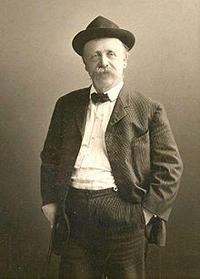Noted archaeologist and naturalist Charles Conrad Abbott (1843 – 1919) made his home at the edge of the Marshlands for many years. In 1872, he reported finding man-made implements in the Trenton glacial gravels on his farm. This discovery sparked an international debate and forty-year controversy concerning the antiquity of man in the New World. The controversy made the Abbott Farm District one of the best known archaeological sites in eastern North America to scientists on two continents, and to the American public.

Eventually, Abbott’s claim that man was present in the North America prior to the end of the ice age was disproven. But many significant archeological artifacts were discovered on the Abbott farms and surrounding area by Abbott and others. It is recognized by archeologists today as the largest site for Middle Woodland occupation in the Northeast and has been a key component of reconstructing the lifeways of the prehistoric inhabitants. Because of its archaeological importance, the area that includes much of the Marshlands was designated the Abbott Farm District National Historic Landmark by the United States Department of Interior in 1976.
Charles Conrad Abbott grew up in Trenton, but as a boy loved roaming the meadows, marshes, and upland areas around the farms owned by his extended family on land included in what we know today as the Abbott Marshlands. He was trained as a physician, earning a doctorate degree from the University of Pennsylvania in 1865 but he never practiced medicine. In addition to his work in archeology, he was a naturalist and a prolific writer.
Abbott’s writing about Natural History have sometimes been criticized for being more romantic than scientific. Nevertheless, his colorful descriptions of his rambles over the uplands and meadows of the Abbott Marshlands over 100 years ago resonate with those who roam those same uplands and meadows today and share the same wonder in the delights of the natural world.
“But before wandering long, I find color, and in such abundance and brilliancy that the day needs nothing else to warm the cool shadows. Along the water’s edge, where other growths hold back that they may shed their glory freely, stand in unbroken ranks the lusty stalks of lobelia, weighted with scarlet banners. Even the fresh young summer had nothing to equal this, and here present joy holds us rather than sober retrospection. All efforts seem to have fallen short, however bright the season’s earlier blossoms. Not until now have we seen the crowning effort of nature’s artist. Does there occur anywhere throughout this wide world a more brilliant spectacle than masses of scarlet lobelia in the height of bloom?”
Recent Rambles; Or, In Touch With Nature, p. 203
For description of historical resources see: Abbott Farm National Historic Landmark Interpretive Plan and accompanying Cultural Resource Technical Document
For a listing of books available online see: Online Books of Charles C. Abbott
